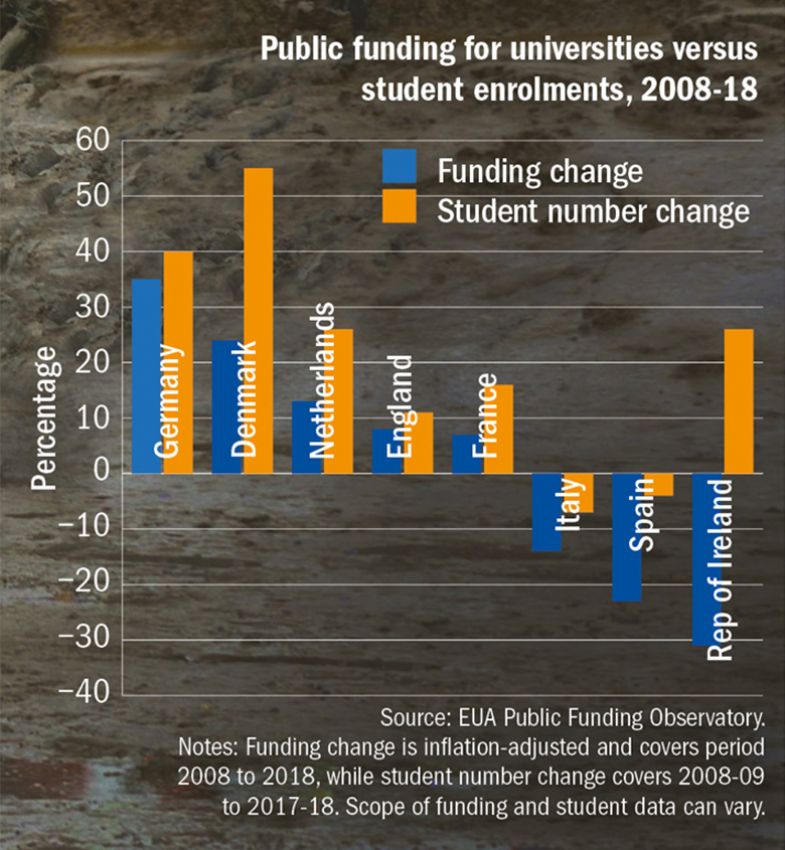Universities across Europe face a continuing squeeze on their finances because government funding is failing to keep pace with growth in student numbers, according to an analysis.
It means that, although figures in the latest Public Funding Observatory report from the European University Association suggest that investment is recovering after years of austerity, institutions often face stark choices, such as whether to let class sizes rise or to spend less on research.
Data from the report, published on 20 February, also suggest that universities may be struggling to make the political case for increasing funding in some nations, with several countries cutting higher education budgets even as their economies grow.
The report represents the 10th anniversary of the study, which uses data on public funding to map real-terms changes in investment in 34 higher education systems across the continent since the start of the global recession in 2008.
It confirms that, overall, there continue to be signs of “gradual improvement” in funding, with only eight systems still investing less in real terms in 2018 compared with 10 years earlier, the lowest number since the financial crisis.
Even some of the countries that have experienced double-digit percentage cuts over the period are now exhibiting signs of improvement, with nations such as the Republic of Ireland – where funding was down by 31 per cent in 2018 compared with 2008 – seeing a boost in funding of 12 per cent from 2018 to 2019.
However, the context of student number changes “gives you a very different picture”, even for countries that have managed to substantially boost funding, according to Thomas Estermann, the EUA’s director for governance, funding and public policy development.
For instance, although Germany recorded a 35 per cent real-terms increase in government funding between 2008 and 2018, there has been a 40 per cent jump in student numbers. In France, funding rose by 7 per cent against a 16 per cent expansion in numbers, and in Denmark the gap was more than 30 percentage points (24 per cent rise in funding, 55 per cent in student numbers).
Institutions struggle to escape fiscal binds

Overall, the EUA report lists eight systems where funding growth has exceeded student enrolment growth, and 10 where it has fallen short.
Mr Estermann said such differences inevitably had to be absorbed by universities in some way. “It has an impact, either on the infrastructure, where you don’t invest for a certain period…or indeed the ratio of student numbers to staff changes, or…you have to make adaptations to the amount of research you undertake,” he said.
The report also shows that although the dozen “most committed” systems had managed to outstrip average economic growth with their public investment in higher education, funding increases were lagging behind the economy’s expansion in four systems, while in nine – including Spain, Ireland and Finland – funding was cut despite gross domestic product increasing.
This represented a “warning signal” that such countries “may miss an opportunity to strengthen their knowledge economy”, the report says.
Mr Estermann said such data gave an indication of the major political debates across Europe around how to prioritise public finances, with the possibility that the settlement for higher education may have been altered for the long term in some places.
Even where funding was brought back in line with economic growth, “it takes a very long time to offset the cuts you made before”, he added.
In addition, there had also been much more emphasis by governments on “value for money” when it came to investment in universities, leading to the increasing use of measures such as competitive funding or performance-related assessments, Mr Estermann said.
Finding the right balance so that such policies did not harm universities by introducing further costs could be “really challenging”, he added, especially in systems struggling for money.
“If you already have a challenge to fund your core activities” in a university, such policies “might not trigger what you have in mind as a funder because it is too little money and universities have other areas where they might need to fix holes in the overall budget”, he said.
Elsewhere, data in the report suggest that universities in Europe have prioritised academic staff positions over those in support roles during the past decade. For instance, in Germany, the Netherlands, Sweden and Denmark, the number of academic staff rose by more than double that of support staff.
One exception, however, was Hungary, where the increase in academics was just 4 per cent over the period, compared with 56 per cent for other staff.
POSTSCRIPT:
Print headline: Student boom eats into funding recovery
Register to continue
Why register?
- Registration is free and only takes a moment
- Once registered, you can read 3 articles a month
- Sign up for our newsletter
Subscribe
Or subscribe for unlimited access to:
- Unlimited access to news, views, insights & reviews
- Digital editions
- Digital access to THE’s university and college rankings analysis
Already registered or a current subscriber?









